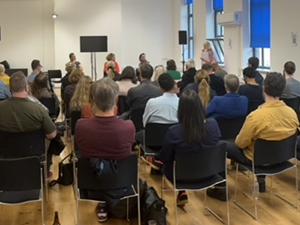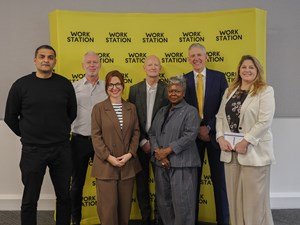Creative Network - Doncaster
South Yorkshire Cultural and Creative Industries Network
Thursday 21 October 2021
Danum Gallery, Library and Museum - Doncaster
Rallying cry from creatives: “We should be shouting about what we’re doing regionally and locally.”
Doncaster is “the place to be looking towards” for a creative scene awash with incredible talent and will be able to maximise its full potential via regional cohesion. Those were the encouraging and inspiring words from Lucy Robertshaw, assistant director at darts, a Doncaster-based participatory arts organisation, who was the first speaker at the Cultural and Creative Industries Network event held in Doncaster on Thursday 21 October.
Lucy was one of six panellists on the evening, which was attended by more than 40 creative practitioners and hosted by Olivia Jones, Creative Director at Doncopolitan. It was an interactive session, with questions from the audience throughout asking a range of questions on topics such as how the creative sector will be impacted by South’s Yorkshire current ‘transitional’ moment.
Lucy added that Doncaster is “ahead of its game” in many arts and cultural areas but that much of what could be done to further this came down to funding. Host Olivia agreed, stating: “If we could secure core funding more, then that would give us the time to do what we do best - create!”
When asked about bringing together the creative sector across the region, panellist Mike Stubbs of Doncaster Creates said there were tremendous benefits to having a “cohesive” approach across Barnsley, Rotherham, Sheffield and Doncaster. “We should be shouting about what we’re doing regionally and locally. But also continuing the levels of engagement that we have here already,” he explained.
Olivia said that there had traditionally been a culture of low self esteem in the sector over the years across the region, which she feels must be addressed via the right support. Lucy said that as a whole, collaboration and fantastic work was starting to see bigger pots of funding for the different areas within South Yorkshire “which is great for creatives.”
Sharing how darts has a 30-year history, with around 40,000 visitors to their building a year, Lucy said the organisation was incredibly proud to nationally and internationally shout about the high standard of creative arts programmes in the area. “The work is so good here, there is so much talent within this region,” she reflected.
darts has secured around £10m for arts and culture in Doncaster over the last ten years - 90% of which was sourced from outside of the borough. “In that time, we've raised over £4m for other artists, community groups and arts organisations in Doncaster, including almost a million to support the opening of CAST and a further £3m to establish Right Up Our Street,” she explained.
Lucy said she hoped that sharing details of recent work and upcoming events would “spark off an idea for collaboration” for people in the network - which is open to all creative practitioners from across South Yorkshire. Lucy said: “You could be a creative practitioner that wants to get into participatory arts and you may want to come and talk to us about your skills, your talent or want to take part in our work.”
Projects spanned a few areas for darts, she explained. This includes their creative directions programme, which supports adults with their mental health and which recently showcased a British Sign Language project. She also shared how through the pandemic, the organisation created free doodle books available for download and visited members of the community because it was imperative to “keep engagement levels up.”
Mike Stubbs, Creative Producer at Doncaster Creates, said that arts and culture is “immediate and present” in everything we do and that it had to be aligned with policy and placemaking. He has been involved in the regeneration of places such as Hull, Liverpool and Melbourne.
“I'm very much into wanting to open up new cultural art forums, new conversations. Often working with people who don't think they're artists and thinking about what an art form can become - to move things outside of the box,” Mike added.
He talked about many programmes being run in the area, including Art Bomb, which relied upon the collaboration of a range of artists and cultural representatives. He shared that a number of projects upcoming were around sustainability, food and natural environment; such as highlighting the area’s history with flooding.
Mike concluded that he would like to see even more arts organisations and projects running to support the region’s economy and those working in the creative sector. “There's a lot of opportunity here to set up arts organisations or for people to operate as independent traders. Or people have got a business and want to make it fly,” he said.
Celebrating South Yorkshire’s creative scene of the future
The second half of the network event featured four creative practitioners in the early years of their professional careers who are ambitious about the future of the South Yorkshire creative industries and cultural sector.
Freelance Creative Producer Lauren Townsend talked passionately about her Children of the Night project, which she described as a “bold exploration of Doncaster’s notorious and infamous 90s nightclub culture.”
“The project spans theatre, exhibition and community participatory arts. It explores key themes such as working class identity, female ambition and empowerment, nostalgia, sexual health and media sensationalism,” she told the audience.
In her role, she enjoyed curating the project but also acknowledged that much of her time is spent striking up partnerships and securing funding. Lauren concluded: “We're really excited to be embarking on the next stage of development. We're always constantly looking for Yorkshire based artists, organisations, funders, investors, who would be interested in working with us and collaborating with us more to see this project through.”
Creative Director Sam Dunstan, who is involved in live events and theatre organisation Growth House, works in immersive theatre and talked about his career journey. Born and bred in Doncaster, Sam trained elsewhere in the UK but returned to South Yorkshire because he likes to collaborate with people who “push my thinking.” Recently, this led to a fantastic partnership with a local painter, who he said brought another dimension to a production he is working on that explores male suicide rates and mental health.
Despite there typically being a culture of ‘low self-esteem’ in the sector in the past, Sam said that’s hugely improved in recent years and people see the real value that comes from the sector. He expanded: “I worked in London for seven years, and I've never been more creatively excited than since moving back. Moving back was the best decision I ever made for my career. For my collaborators, from our partnerships, we're meeting wonderful, exciting people. Now, we just got to push that to the next level. And I think we can.
“We've got so many sparks firing off at the minute. We just need some funding, we need some space. We need some centralisation. And we need some secrecy to disappear between organisations and freelancers, and between freelancers as well. When you start communicating, you collaborate more; and that can only lead to great things.”
Rappers David Walusimbi and Lewis Russell of GSD started collaborating just as the pandemic started. They used this as a springboard to work closely with several artists, videographers, rappers, singers and producers to create a platform to share music - identifying venues, exhibitions and organising TedX talks to share performances.
They explained: “We want to continue to make a platform for people so there's more opportunity in our space. Because while there's a lot of music in Doncaster, there's not much of our kind of genre. We want to open the opportunity for younger creatives.
“When we were growing up, a lot of our friends had outlets but didn’t know where to put it. Then they've given up because there's been nowhere to go with it initially. The opportunity needs to be open to everyone.”
Host Olivia said it was incredible to hear from younger creatives who are “pushing the boundaries” of what can be done in the region and that was so important for the future of the sector.
Lauren added that as a child, she was encouraged to keep to a career that was in “one lane” and that couldn’t be deviated from. She thinks this is the wrong approach completely and now works with young people to explain why. Lauren explained: “A lot of the work that I do is developing young artists and working with children and young people through art. And one thing I always say to them is never, ever limit yourself. Don't let anybody tell you that you have to do one thing.”
Sam added: “If you want to do anything, you can get it done wherever you are. If you've got less resources, it just means you have to be more resourceful. And having your fingers in more pies gives you more opportunities. Because if you don't quite know where you're going, you'll find your way.”
All four young creatives said that while it was important to nurture talent from within the region via giving opportunities and networks to help realise ambition and utilise the wealth of talent; it was also crucial to attract new voices from elsewhere. They said this would bring about a truly diverse Cultural and Creative Industries sector for South Yorkshire which also draws in larger audiences. That is, they feel, the way to grow the sector for the long-term.
Showroom Membership
Show us some love by joining our club >
Support Us
We welcome your support. Find out how you can help us >

